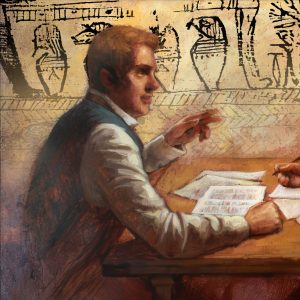Revelations and Translations
10 Episodes
Aside from his Book of Mormon translation project, Joseph Smith engaged in at least three other scripture production projects that we know of. The first was his ambitious Bible translation project we now know as the Joseph Smith Translation. The second was the printing of his own revelations, which we now know as the Doctrine and Covenants. And the third was his project of translation which commenced after he acquired Papyrus scrolls from Egypt, which culminated in what we now know as the Book of Abraham. In this new series Scott and Casey will consider each of these fascinating projects in turn, including the points of controversy connected with each.

Composite image. Original artwork by Annie Henrie
Episodes
Episode 1
What Do We ACTUALLY Know About the JST?
In this first episode, we begin our exploration of Joseph Smith’s translation of the Bible, or the JST for short. When did it begin? Why didn’t we get this into Latter-day Saint Bibles until 1979? What does the word “translate” mean in this context in light of the fact that Joseph Smith didn’t know Hebrew or Greek during this project? And what are some common assumptions church members often bring to the text of the JST that may not be warranted?
58 Min
Episode 2
The JST as Revelatory Springboard?
Because there are no explicitly stated purposes of Joseph Smith’s Bible translation project, either by him or in any of his revelations, all explanations offered about or criticisms leveled at his Bible translation are based on assumptions and best guesses at best, but then, of course, there’s nothing wrong with educated best guesses, so long as we’re not overly dogmatic and we humbly recognize the tentativeness of our position. The current best evidence from the best scholarship …
55 Min
Episode 3
Did Joseph Smith Plagiarize Part of the JST?
In his Bible translation project, did Joseph Smith plagiarize the work of a prominent British scholar named Adam Clark? Or, if you don’t want to call it plagiarism, did Joseph Smith borrow or appropriate phrases or ideas from Adam Clark’s Bible commentary without attribution which are found in our JST footnotes today? This is the question at the heart of the biggest modern controversy surrounding Joseph Smith’s Bible translation. In today’s episode of …
60 Min
Episode 4
Q&R! Tough JST Questions with Kent Jackson
Did Joseph Smith ever consider his Bible translation work finished? Will the JST ever be canonized and replace the King James Version as the official Latter-day Saint Bible? Why haven’t any other of our prophets since Joseph Smith engaged in similar translation work? How can we reconcile Joseph Smith’s Bible revision work with Deuteronomy 4:2 and Revelation 22:19, which actually warn against adding to the Bible? Is there any evidence whatsoever that …
50 Min
Episode 5
Exploring the Divine-Human Partnership in Scripture Creation | Featuring the D&C
One of the biggest criticisms of scripture generally is the extent to which humans were involved in its production. On the one hand, we can’t really expect scripture to be effortlessly beamed down from heaven to flawed and imperfect humans and then interpreted flawlessly and recorded perfectly, can we? But on the other hand, how divine and trustworthy can scripture be if flawed humans were involved in writing it, compiling it, editing it, and publishing it? In …
54 Min
Episode 6
How Has Canonizing/De-Canonizing Happened in the Doctrine & Covenants?
Because of our location in time and good record keeping, we are privileged to have an up close and personal view of the production of modern scriptural canon, and as we get into it, it’s a bit of a rollercoaster. From its first publication in 1835 to its current version today, the Doctrine and Covenants has undergone major additions, deletions, rearrangements, and textual changes. In today’s episode of Church History Matters, we’ll take a ride through the history of …
62 Min
Episode 7
The Book of Abraham: Origins and Controversies
The Book of Abraham, Joseph Smith’s final translation project, is easily one of the most controversial books of scripture in the Latter-day Saint canon, and we want to talk about it. In today’s episode of Church History Matters, we dig into the fascinating story of how the exploits of a 19th-century grave robber in Egypt ended up expanding our scriptural canon. We look at where in Egypt the papyri from which the Book of Abraham was purportedly translated came from, and how …
56 Min
Episode 8
The Abraham Facsimile Conundrum: Is it All or Nothing?
In Joseph Smith’s interpretations of the facsimiles found in our Pearl of Great Price, he ties all three of them to Abraham, yet when some modern Egyptologists look at those same facsimiles today, they say they have nothing to do with Abraham. One is simply an embalming scene, they say, one a disc representing the eye of Horus, and one a judgment scene from an Egyptian Book of the Dead. So, is this an either-or, sudden-death scenario? Must we, in the name of honesty …
56 Min
Episode 9
Beyond Book of Abraham Controversies
So the book of Abraham is the touchpoint of some serious controversies, and we’ve talked about some of those in our last two episodes, and we’ll probably talk about them more in the next episode. But, to be clear, the book of Abraham is also the source of some dazzling doctrinal gems which validate and expand upon other key restoration teachings. So in this episode of Church History Matters, we leave the controversial to bask, however briefly, in what to us makes …
64 Min
Episode 10
Q&R with Dr. Kerry Muhlestein! Tough Book of Abraham Questions
So there was, in 2nd century BC Egypt, an indisputable, multicultural sharing of religious ideas between Jews, Greeks, and Egyptians. How should that fact influence how we evaluate Joseph Smith’s interpretations of the Abraham facsimiles in general and individual hieroglyphics on the facsimiles specifically? On a related note, some of Joseph’s descriptions of Facsimile 2 contain temple themes, saying that more will be revealed about those in the temple. Can Egyptologists …
